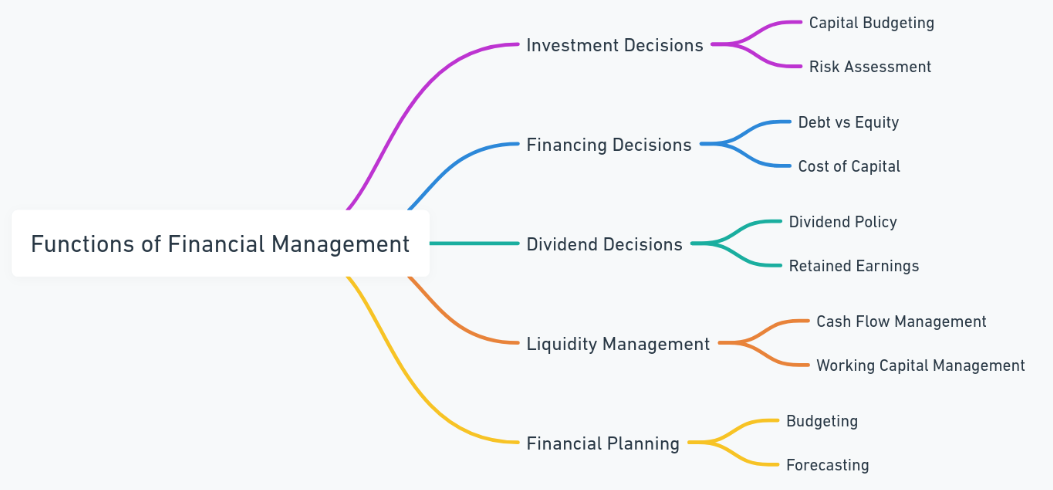Financial management is one of the most important aspects of any business and plays a vital role in keeping the finances of a company healthy and ensuring long-term profitability. It is concerned with planning, organizing, directing, and controlling financial activities for securing and using funds at the maximum profitability. The prime objective of financial management is to maximize the firm’s value for its shareholders while there is always an element of managing financial risks. All businesses need the careful management of their finances so they can meet their operational requirements and invest in growth opportunities, and the vagaries of the market.
What is Financial Management?
Financial management refers to planning, organizing, controlling, and monitoring financial resources in order to achieve organizational goals. This management is very vital as far as business decisions are concerned; it ensures the growth and sustainability of the organization because it has various functions, such as budgeting, investment decisions, and risk management.
This would mean that financial management aligns the available resources of a company with both short-term and long-term goals. For example, while ensuring liquidity is being planned for day-to-day operations in the short term, then investment and capital budgeting for growth is a major focus of the long-term planning process.
What are the Functions of Financial Management?
Financial management can be broadly categorized into several key functions, each vital for maintaining financial stability and achieving strategic goals. These include:
1. Financial Planning and Forecasting
The basic functions of financial management include financial planning and forecasting. It encompasses estimating the financial requirements of business and ensuring that adequate funds are available to fulfill these needs. Financial forecasting based on historical data and market trends portrays the prospects of revenue, expenses, and capital as well, for proper decision-making about future growth and investments.
- Financial Planning: It assists in deciding how much capital is to be required for expansion or new projects undertaken by the firm.
- Financial Forecasting: Assists in determining any potential income and expenses for subsequent periods which are helpful in anticipation of future cash flow requirements.
2. Cash Management
Efficient cash management will ensure that a business has sufficient liquidity to pay its short-term obligations, such as suppliers, employees, and creditors. Cash management therefore refers to the process of following the inflows and outflows of cash and ensuring that the company has adequate liquid resources while maximizing the returns on any surplus cash.
Objectives of Cash Management: To ensure sufficient liquidity, optimize cash holdings, and invest surplus cash wisely.
3. Forecast of Cash Flow
Proper cash flow prediction is essential for ensuring that a company has enough funds to handle operations. The company must predict when and how much cash will be needed for the payroll, payment to vendors, and loan repayment.
Advantages of Cash Flow Forecasting: Reduces liquidity crises. Avoids overborrowing that helps plan for large expenditures.
4. Estimating Capital Expenses
Capital expenditures are long-term investments a firm makes in the business for improvement or expansion of operations. Financial management plays a critical role in determining the need for capital investment in projects such as purchasing new equipment, expanding facilities, or a new product line. Propped estimation will avoid under- or over-investment, which can pose a significant financial burden.
Key Focus: The forecasting of future capital needs should be aligned with the strategic goals of the company.
5. Determining Capital Structure
A company, therefore, uses a mix of debt and equity for funding its operations; financial management determines the optimal capital structure that can minimize cost while maximizing profit by deciding the amount of capital to be generated from debt as borrowed funds and the amount coming from equity in terms of shareholder funds. A well-balanced capital structure will reduce the risk associated with it and also contribute to better financial health for the company.
Common considerations include the relationship between debt and equity, cost of capital, risk of bankruptcy, and return on equity.

6. Choosing Sources of Funds
A firm can get funds through sources such as equity, debt, or internal reserves. The financial manager is tasked with determining the most appropriate sources of funds for the firm depending on cost, risk factors, and overall company objectives.
- Equity Financing: It is a source of funds whereby the company raises capital with the help of the issuance of shares of the firm.
- Debt Financing: It is borrowing money through loans or bonds that must be repaid with interest.
7. Procurement of Funds
Fund procurement refers to the acquisition of finance to meet the investment and operating needs of the business. Identification of appropriate funding sources and negotiation with terms for getting funds at the cheapest cost possible are involved. Additionally, proper timing for acquiring funds that the company intends to use is required from financial managers.
Key Focus: Cost efficiency, timing, and sustainability of funding sources.
8. Investment of Funds
Investment of funds is an allocation of capital in various forms of assets or projects that one expects to earn returns sometime in the future. This role includes decisions regarding the need to invest surplus funds in new ventures, equipment, or securities. Such investment decisions must be in line with the long-term policy and financial goals of the firm.
Investment Decisions: Should be aligned with risk appetite, potential return, and corporate strategy.
9. Surplus Disposal
At the point of surplus generation, wherein its profit exceeds the immediate needs of the business, financial management has to decide where the surplus should go. The options could be reinvesting in the business, paying dividends to shareholders, or holding the surplus as a reserve for future needs.
Major Issue: A balance between reinvestment and rewarding shareholders.
Types of Financial Management
Two main types of financial management exist and therefore are used to address various needs of organizations. Each type has been emphasized on specific aspects of how to manage an organization’s financial resources correctly.
Strategic Financial Management
Strategic financial management: It is a long-term planning towards the attainment of goals by the company. It emphasizes wealth maximization among shareholders through deliberate investment, mergers and acquisitions, and restructuring of capital. This form of financial management is concerned with how the financial strategy will be aligned to the long-term vision of the company.
Example: Planning to acquire a competitor or entering a new market.
Tactical Financial Management
Tactical financial management is managing the short-term finances of an organization, which impacts its operations. It includes managing the cash flow to keep the company liquid and at optimum levels of working capital. The short-term gains should not severely affect the long-term objectives in such a manner.
Example: Managing daily cash flow or negotiating better credit terms with suppliers.
Conclusion
Financial management is the skeleton of any successful business, ensuring that the resources are being used in the best possible way and that a company remains financially sound. With careful planning, budgeting, and monitoring, financial managers can guide a company toward the realization of both short-term and long-term objectives. Financial planning, cash management, and investment decisions constitute the core basis through which financial management grows, innovates, and becomes competitive in its marketplace.
Functions of Financial Management FAQs
What is the primary goal of financial management?
The primary goal of financial management is to maximize shareholder value while managing financial risks effectively.
Why is cash flow forecasting important?
Cash flow forecasting helps ensure that a company has enough liquidity to meet its obligations and avoid financial crises.
What is the difference between strategic and tactical financial management?
Strategic financial management focuses on long-term goals, while tactical financial management addresses short-term financial needs.
How does determining the capital structure benefit a business?
Determining the optimal capital structure helps minimize the cost of capital and balance the risk between debt and equity financing.
What are the key considerations when choosing sources of funds?
Key considerations include the cost of funds, risk, and alignment with the company’s long-term goals.


